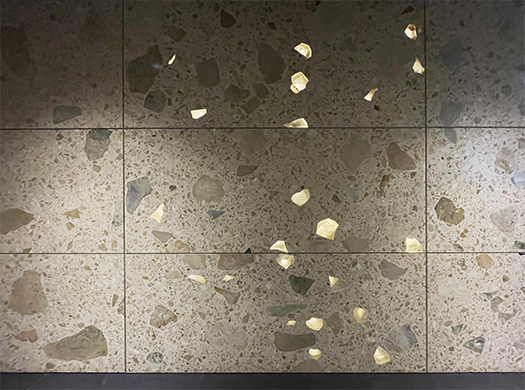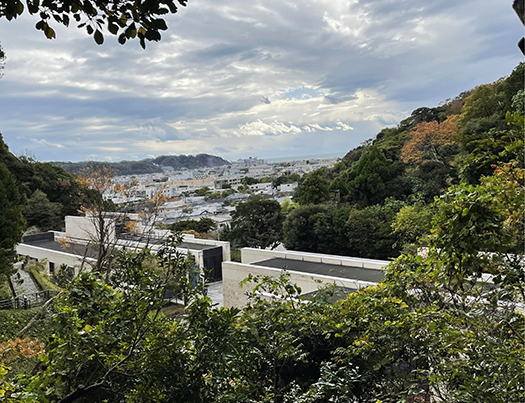

きのうは家形石棺について書きましたが、人間というのはさすがに「石器時代」という歴史発展を過ごしてきている生物種なので、石には独特の感受性があると思っています。
家形石棺は群集墳に葬られる一般のひとびとであり、特権階級は「注文住宅」的な大規模古墳に埋葬されたけれど、どちらかというと規格住宅的な埋葬方法だったと思えた。そういう階級差、身分差というものはあったのだろうけれど、死後、石の壁、床、天井に包まれて過ごすということでは本質的に差はない。
石を加工して使う、それも輪廻転生の願いを込めてその石造空間にいだかれて死後の世界と向き合う、というのは、人類普遍の願望憑依なのでしょう。強く納得感がある。
写真は建築家ノーマン・フォスターによる鎌倉歴史文化交流館です。
西欧人というのは石の建築文化のはるかな伝統を持続しているけれど、そういう空間性にはわたしも深く頷かされている。わが家はコンクリートブロックというアメリカから製法が輸入された建築材料で建てた。また、わたしの父もはじめて食品製造の蔵屋を建てたとき、このコンクリートブロックで建てた経緯がある。
自分の建てた家について話さなければならない竣工の時、父の建てた建物と同じ構造素材であることにあらためて気付かされたことがあった。
きっと少年時の建築体験が沈殿して、石造というものに好ましさを感じていたのだろう。
それ以来、わが家の壁面をみながら人生時間を過ごしてきた。素地のその風合いにずっと、
「こころが吸い取られている」ような感覚を抱いている。別にオカルト志向ではありませんが、石に囲まれて「終の住み処」に至った古代のひとびとにシンパシーを感じている。
そんな気分があって、ノーマンフォスターの建築素材へのこだわり、イタリア・ドイツという石造の建築文化が投影されたシルエット、壁面と向き合うのが好きです。これらの石材は自然そのものではなく、工場加工を施したものなのだという。写真の光沢のある部位などには硝子などの異素材も投入されている。それらが見る角度や場所によって表情を変えてくれる。
吸い取られる、という感覚とはまた別に反射してくるような感覚も抱かせられる。きっと、いつまでもこの建物には惹き付けられ続けるのではないだろうか。
やや諦念にも似た同意の感覚があります。しょがなく好きなのでしょう。
English version ⬇
[Gradually, I’m being drawn to the stones [laughs].
The walls of architect Norman Foster’s Kamakura History and Culture Exchange Center are drawing me in. I was surprised to see such a glittering stone. You can’t help but like it. …
Yesterday I wrote about house-shaped sarcophagi, and I believe that humans have a unique sensitivity to stone because we are a species that has lived through the historical development of the “Stone Age.
The house-shaped sarcophagi were for ordinary people buried in group burial mounds, while the privileged class was buried in large “custom-built” burial mounds, but I think the burial method was more like a standardized house. Although there may have been differences in class and status, there is no essential difference in the fact that after death, people spend their days wrapped in stone walls, floors, and ceilings.
The use of processed stone, and the desire to reincarnate and face the afterlife in this stone space, must be a universal desire possession of humankind. It is strongly convincing.
The photo shows the Kamakura Museum of History and Culture by architect Norman Foster.
Westerners have a long tradition of stone architecture, and I am deeply impressed by this spatiality. My house was built with concrete blocks, a building material imported from the United States. My father also built his first food manufacturing warehouse with concrete blocks.
When I had to talk about the house I had built, I was reminded of the fact that it was made of the same structural material as the building my father had built.
It must have been the precipitation of my architectural experiences as a boy that made me feel a fondness for masonry.
Since then, I have spent my life looking at the walls of my house. The texture of the bare stone has always been with me,
I feel as if my mind is being absorbed by the texture of the stone. I am not an occultist, but I feel sympathy with the people of ancient times who lived in their “final dwelling place” surrounded by stones.
With such a feeling, I like to face the silhouettes and wall surfaces that project Norman Foster’s attention to architectural materials and the stone architectural culture of Italy and Germany. These stone materials are not nature itself, but factory-processed. Different materials such as glass are also used for the glossy parts in the photo. These materials change their expressions depending on the angle and location of the viewer.
It gives us a sense of being absorbed, but also a sense of being reflected. I am sure that this building will continue to attract me forever.
There is a sense of agreement, somewhat like resignation. I guess I like it without a clue.
Posted on 11月 24th, 2023 by 三木 奎吾
Filed under: 住宅マーケティング







コメントを投稿
「※誹謗中傷や、悪意のある書き込み、営利目的などのコメントを防ぐために、投稿された全てのコメントは一時的に保留されますのでご了承ください。」
You must be logged in to post a comment.